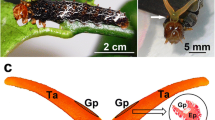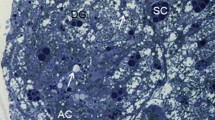Abstract
During the settlement of Ostrea edulis L., the foot of the pediveliger implements temporary attachment and cementing. The morphology of the foot has been re-examined to try to clarify its role during this period. The foot has a highly developed nervous system and musculature, but mainly consists of sub-epidermal gland cells of 9 different types. Cells of the first gland contain acid mucopolysaccharide, and open over the ventral surface of the foot. The second type of gland contains a neutral glycoprotein, and opens at the tip of the foot. The third gland opens mid-ventrally half way down the foot, and largely contains an aromatic protein. The fourth type of gland contains mainly proteoglycan, and the cells open mid-ventrally behind the third gland. The fifth gland contains acid mucopolysaccharide, and the cells open onto the heel of the foot. The sixth, seventh, eighth and ninth glands contain a variety of acid mucopolysaccharides, proteoglycans and possibly a neutral glycoprotein; their cells open into the byssus duct, which discharges at the base of the heel. The grouping of the glands, position of the openings of the cells, and histochemical properties of the secretions suggest that they may be involved in localised and general adhesion of the foot during temporary attachment, as well as in cementing of the larva.
Similar content being viewed by others
Literature Cited
Adams, C. W. M.: A p-dimethyl aminobenzaldehyde-nitrite method for the histochemical demonstration of tryptophane and related compounds. J. clin. Path. 10, 56–62 (1957).
Baker, J. R.: The histochemical recognition of certain guanidine derivatives. Q. Jl microsc. Sci. 88, 115–121 (1947).
— The histochemical recognition of phenols, especially tyrosine. Q. Jl microsc. Sci. 97, 161–164 (1956).
Barrett, A. J.: The biochemistry and function of mucosubstances, with particular reference to those of cartilage. Proc. R. microsc. Soc. 5, 212–214 (1970).
—: The biochemistry and function of mucosubstances. Histochem. Jl 3, 213–221 (1971).
Barrnett, R. J. and A. M. Seligman: Demonstration of protein bound sulphydryl and disulphide groups by two new histochemical methods. J. natn. Cancer Inst. 94, 176–183 (1952).
——: Histochemical demonstration of protein-bound alpha acylamido carboxyl groups. J. biophys. biochem. Cytol. 4, 169–176 (1958).
Brachet, J.: The use of basic dyes and ribonuclease for the cytochemical detection of ribonucleic acid. Q. Jl microsc. Sci. 94, 1–10 (1953).
Burstone, M. S.: An evaluation of histochemical methods for protein groups. J. Histochem. Cytochem. 3, 32–49 (1955).
Cole, H. A.: The fate of the larval organs in the metamorphosis of Ostrea edulis. J. mar. biol. Ass. U.K. 22, 469–484 (1938).
— and E. W. Knight-Jones: Some observations and experiments on the setting behaviour of larvae of Ostrea edulis. J. Cons. perm. int. Explor. Mer 14, 86–105 (1939).
Dorsett, D. A. and R. Hyde: The spiral glands of Nereis. Z. Zellforsch. mikrosk. Anat. 110, 204–218 (1970a).
—: The epidermal glands of Nereis. Z. Zellforsch. mikrosk. Anat. 110, 219–230 (1970b).
Erdmann, W.: Untersuchungen über die Lebensgeschichte der Auster. Nr 5. Über die Entwicklung und die Anatomie der „ansatzreifen” Larve von Ostrea edulis mit Bemerkungen über die Lebensgeschichte der Auster. Wiss. Meeresunters. (Abt. Helgoland) 19, 1–25 (1934).
Foster, B. A. and J. A. Nott: Sensory structures in the opercula of the barnacle Elminius modestus. Mar. Biol. 4, 340–344 (1969).
Geyer, G.: Dei Sulfonsäurenachweis. Eine neue Methode für den histochemischen Nachweis von Sulfonsäuren. Acta histochem. 14, 26–41 (1962).
Glenner, G. G. and R. D. Lillie: Observations on the diazotization-coupling reaction for the histochemical demonstration of tyrosine: metal chelation and formazan variants. J. Histochem. Cytochem. 7, 416–422 (1959).
Hickman, R. W.: A histological study of metamorphosis in the larva of Ostrea edulis. M. Sc. thesis, 52 pp. University College of North Wales 1969.
— and Ll. D. Gruffydd: The histology of the larva of Ostrea edulis during metamorphosis. In: Fourth European marine biology symposium, pp 281–294. Ed. by D. J. Crisp. Cambridge: Cambridge University Press 1971.
Hunt, S.: Polysaccharide-protein complexes in invertebrates, 329 pp. London and New York: Academic Press 1970.
Knight, D. P.: Sclerotization of the perisarc of the calyptoblastic hydroid, Laomedea flexuosa. 1. The identification and localisation of dopamine in the hydroid. Tissue Cell 2, 467–477 (1970).
—: Sclerotization of the perisarc of the calyptoblastic hydroid, Laomedea flexuosa. 2. Histochemical demonstration of phenol oxidase and attempted demonstration of peroxidase. Tissue Cell 3, 57–64 (1971).
Laskey, A. M.: A modification of Mayer's mucihaematein technic. Stain Technol. 25, 33–34 (1950).
Mazia, D., P. A. Brewer and M. Alfert: The cytochemical staining and measurement of protein with mercuric bromophenol blue. Biol. Bull. mar. biol. Lab., Woods Hole 104, 57–67 (1953).
Mowry, R. W.: The special value of methods that colour both acidic and vicinal hydroxyl groups in the histochemical study of mucins, with revised directions for the colloidal iron stain, the use of Alcian blue G8X and their combinations with the periodic acid-Schiff reaction. Ann. N.Y. Acad. Sci. 106, 402–423 (1963).
— and J. E. Scott: Observations on the basophilia of amyloids. Histochemie 10, 8–32 (1967).
Munger, R. L.: Staining methods applicable to sections of osmium-fixed tissue for light microscopy. J. biophys. biochem. Cytol. 11, 502–506 (1961).
Nachlas, M. M., D. T. Crawford and A. M. Seligman: The histochemical demonstration of leucine aminopeptidase. J. Histochem. Cytochem. 5, 264–278 (1957).
Nelson, T. C.: The attachment of oyster larvae. Biol. Bull. mar. biol. Lab., Woods Hole 46, 143–151 (1924).
Nott, J. A.: Settlement of barnacle larvae: surface structure of the antennular attachment disc by scanning electron microscopy. Mar. Biol. 2, 248–251 (1969).
— and B. A. Foster: On the structure of the antennular attachment organ of the cypris larva of Balanus balanoides (L.). Phil. Trans. R. Soc. (Ser. B) 256, 115–134 (1969).
Pearse, A. G. E.: Histochemistry theoretical and applied. Vol. 1. 3rd ed. 759 pp. London: Churchill 1968.
Pedersen, K. J.: Slime-secreting cells of planarians. Ann. N.Y. Acad. Sci. 106, 424–442 (1963).
—: Cytological and cytochemical observations on the mucous gland cells of an acoel turbellarian, Convoluta convoluta. Ann. N.Y. Acad. Sci. 118, 930–965 (1965).
Prytherch, H. F.: The role of copper in the setting, metamorphosis, and distribution of the American oyster, Ostrea virginica. Ecol. Monogr. 4, 45–107 (1934).
Ronkin, R. R.: Some physicochemical properties of mucus. Archs Biochem. Biophys. 56, 76–89 (1955).
Scott, J. E. and J. Dorling: Differential staining of acid glycosaminoglycans (mucopolysaccharides) by Alcian blue in salt solutions. Histochemic 5, 221–233 (1965).
— and R. A. Stockwell: Reversal of protein blocking of basophilia in salt solutions: implications in the localization of polyanions using Alcian blue. J. Histochem. Cytochem. 16, 383–386 (1968).
—: On the use and abuse of the critical electrolyte concentration approach to the localization of tissue polyanions. J. Histochem. Cytochem. 15, 111–115 (1967).
Shimizu, N. and R. Kumamoto: A lead tetra-acetate Schiff method for polysaccharides in tissue sections. Stain Technol. 27, 97–106 (1952).
Smyth, J. D.: A technique for the histochemical demonstration of polyphenol oxidase and its application to egg-shell formation in helminths and byssus formation in Mytilus. Q. Jl microsc. Sci. 95, 139–152 (1954).
Spicer, S. S.: Diamine methods for differentiating mucosubstances histochemically. J. Histochem. Cytochem. 13, 211–234 (1965).
Stafford, J.: The Canadian oyster its development, environment and culture, 159 pp. Ottawa: Commission of Conservation Canada 1913.
Steedman, H. F.: Ester wax: a new embedding medium. Q. Jl microsc. Sci. 88, 123–133 (1947).
Storch, V. and U. Welsch: The ultrastructure of epidermal mucous cells in marine invertebrates (Nemertini, Polychaeta, Prosobranchia, Opisthobranchia). Mar. Biol. 13, 167–175 (1972).
Whur, P.: Biosynthesis of glycoproteins as revealed by electron microscope autoradiography. Thyroglobulin and cell coat material. Proc. R. microsc. Soc. 5, 219–220 (1970).
—, A. Hersovics and C. P. Leblond: Radioautographic visualization of the incorporation of galactose -3H and mannose -3H by rat thyroids in vitro in relation to the stages of thyroglobulin synthesis. J. Cell Biol. 43, 289–311 (1969).
Williams, G. and P.S. Jackson: Two organic fixatives for acid mucopolysaccharides. Stain Technol. 31, 189–191 (1956).
Author information
Authors and Affiliations
Additional information
Communicated by G. F. Humphrey, Sydney
Rights and permissions
About this article
Cite this article
Cranfield, H.J. A study of the morphology, ultrastructure, and histochemistry of the food of the pediveliger of Ostrea edulis . Mar. Biol. 22, 187–202 (1973). https://doi.org/10.1007/BF00389173
Accepted:
Issue Date:
DOI: https://doi.org/10.1007/BF00389173




